The Intel Kaby Lake-X i7 7740X and i5 7640X Review: The New Single-Threaded Champion, OC to 5GHz
by Ian Cutress on July 24, 2017 8:30 AM EST- Posted in
- CPUs
- Intel
- Kaby Lake
- X299
- Basin Falls
- Kaby Lake-X
- i7-7740X
- i5-7640X
The Fastest for Serial Workloads
If you asked ‘what made the best processor’ fifteen years ago, the obvious answers were performance, power and price. As time has marched on, this list has started to include integrated graphics, bandwidth, platform integration, platform upgradability, core-to-core latency, and of course, cores. Marching up from a single x86 core through to CPUs that carry 10 cores for consumers, 28 cores for enterprise and 72 cores for add-in cards makes the task of creating a perfect processor almost impossible – there is no way to satisfy all of the properties that build a processor today. Both AMD and Intel start from basic building blocks (a single core) and then configure processors around that core, adding in more cores, connectivity, and then binning to the right voltage/frequency and pricing appropriately. The end result is a stack of processors aimed at different segments of the market.
The pair of Kaby Lake-X processors cover one main area listed above more than any others: core performance. By having the latest CPU microarchitecture and placing it on the newest high-end desktop platform there is room at the top for more frequency leading to a higher pure performance product. As a byproduct these CPUs are power efficient, leading to a high performance per watt, and are situated in a platform with extensive IO options. Ultimately this is where the Kaby Lake-X customer will sit: someone who wants high single thread performance but is not after massive multi-core performance. This would typically cover the majority of gamers and enthusiasts, but not necessarily content creators.
The benefits in the benchmarks are clear against the nearest competition: these are the fastest CPUs to open a complex PDF, at the top for office work, and at the top for most web interactions by a noticeable amount.
The downsides are pure throughput workflows, such as neuron simulation, rendering and non-video encoding.
The parts in the middle are the ones to dissect, and these get interesting. Let me pull up a few graphs that illustrate this middle of the road position: Chromium Compilation, Agisoft Photoscan and WinRAR.
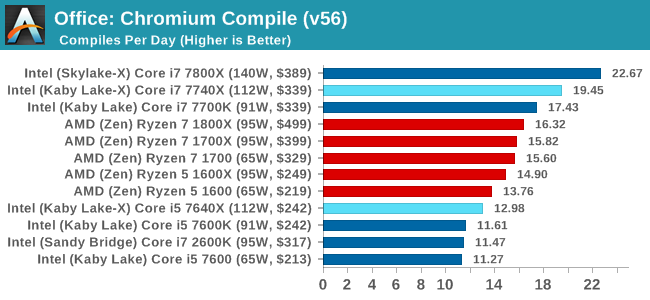
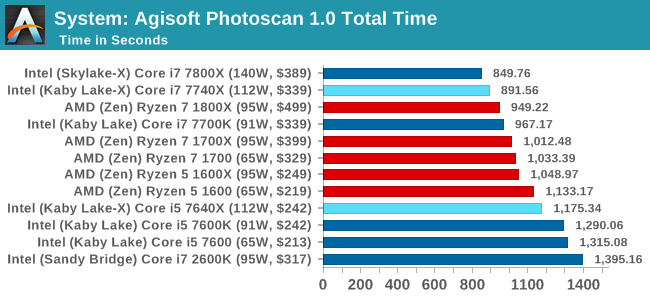
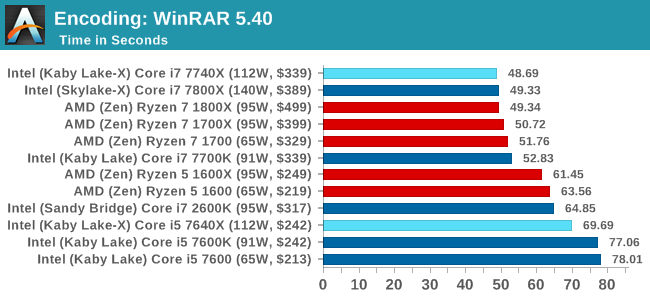
These three results show the Core i7-7740X performing above any AMD chips of similar price, but the Core i5-7640X performing below any Ryzen 7 or Ryzen 5 parts. This comes down to the workload in each of these benchmarks, and how the processor configurations affect that. All three of these real-world benchmarks are variable-thread workloads. Some elements are serialized and rely on a high single-thread performance, while other elements are fully parallelizable and can take advantage of cores and threads (sometimes threads do not necessarily help). The benchmarks are ultimately limited by Amdahl’s Law, where single thread speed affects the whole test, but multiple-threads only helps the parallelizable parts. With sufficiently parallelizable code, it becomes a balance between the two.
So for the Core i7-7740X, up against the Ryzen 7 1700 at an equivalent price, the Core i7 has eight threads and the Ryzen 7 has sixteen, but the Core i7 has a much higher single thread performance. So for these benchmarks, having a high performance metric like this means that despite having half the cores/threads of the AMD part, the Core i7 can take the lead very easily.
But the Core i5-7640X has a different task. It has four cores, like the Core i7, but no hyperthreading, so it sits at four threads. Its direct competitor, the Ryzen 5 1600X, has six cores with simultaneous multithreading, leading to twelve threads. This gives the AMD processor a 3:1 advantage in threads, and for each of these three benchmarks it can parallelize the code sufficiently that the single thread performance of the Intel CPU is not enough. Moving from a 2:1 ratio with the Core i7 to a 3:1 ratio with the Core i5 is a turning point for ST performance compared to MT performance.
So with the X299 confusion, are these CPUs worth recommending?
When Kaby Lake-X first came out, a number of technology experts were confused at Intel’s plans. It made sense to launch the latest microarchitecture on the high-end desktop platform, although launching it in a quad-core form was an idea out-of-left-field, especially for a platform that is geared towards multiple cores, more memory, and more memory bandwidth. In that paradigm, the Kaby Lake-X is an oddball processor design choice.
There are bigger factors at play however – if Intel launched 6-10 core parts on KBL, it would cannibalize their Skylake-X and Skylake-SP sales. Also, as we’ve seen with Skylake-X CPUs, those enterprise cores are now different to the consumer Skylake-S cores, with different cache structures and AVX-512. So if Intel had launched >4 cores on KBL-X, they would have likely had to scrap Skylake-X.
But that’s a slight tangent.
The Core i7-7740X appeals to users who want the fastest out-of-the-box single thread x86 processor on the market today. This means financial traders, gamers, and professionals working with serial code bases, or anyone with deep pockets that might think about upgrading to Skylake-X in the future. Enthusiast overclockers are likely to find the better binned CPUs fun as well.
That’s if you do not mind paying a premium for the X299 platform. For users who mind the cost, the Core i7-7700K is 98% of the way there on performance but can save a hundred dollars on the motherboard and offers the same functionality. In some of our benchmarks, where despite the high single thread performance having more cores helped, then spending a little more on the Skylake-X six-core Core i7-7800X is beneficial: for example, Luxmark and POV-Ray scored +33% for the 7800X over the 7740X.
The Core i7-7740X makes certain sense for a number of niche scenarios. By contrast, the Core i5-7640X doesn’t make much sense at all. There’s still the benefit of high single-thread performance and some good gaming performance in older titles, but in the variable threaded workloads it loses to AMD’s processors, sometimes by as much as 45%. For a chip that comes in at $242, users should expect to pay about the same on a motherboard – whereas either an AMD part or the Core i5-7600K can go in a $120 motherboard and still be overclocked.
There are only two scenarios I can see where the Core i5 adds up. Firstly, users who just want to get onto X299 now and upgrade to a bigger CPU for quad-channel memory and more PCIe lanes later. The second is for professionals that know that their code cannot take advantage of hyperthreading and are happy with the performance. Perhaps in light of a hyperthreading bug (which is severely limited to minor niche edge cases), Intel felt a non-HT version was required.
In our recent CPU Buyers’ Guide (link autoupdates to the latest CPU guide) we suggested the Core i7-7740X for anyone wanting a Peak VR experience, and we still stand by that statement. It has enough threads and the biggest grunt to take on VR and the majority of enthusiast gaming experiences, if a user has pockets big enough.
The recommendations of the new CPUs boil down to platform costs. They seem a minor upgrade to the Kaby Lake-K processors and the Z270 platform, which is a platform that caters to a big audience with a more cost-sensitive structure for motherboards in mind.


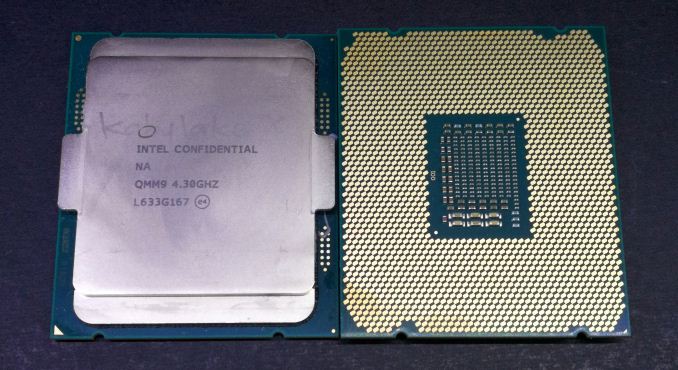
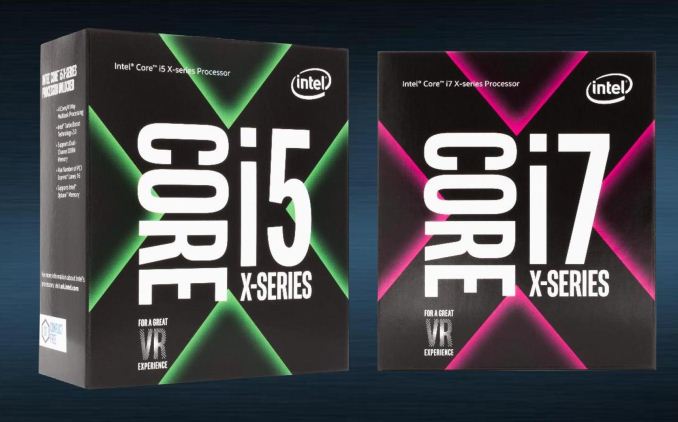








176 Comments
View All Comments
MTEK - Monday, July 24, 2017 - link
Random amusement: Sandy Bridge got 1st place in the Shadow of Mordor bench w/ a GTX 1060.shabby - Monday, July 24, 2017 - link
That's funny and sad at the same time unfortunately.mapesdhs - Monday, July 24, 2017 - link
S'why I love my 5GHz 2700K (daily system). And the other one (gaming PC). And the third (benchmarking rig), the two I've sold to companies, another built for a friend, another set aside to sell, another on a shelf awaiting setup... :D 5GHz every time. M4E, TRUE, one fan, 5 mins, done.GeorgeH - Monday, July 24, 2017 - link
Those decreased overclocking performance numbers aren't just red flags, they're blinding red flashing lights with the power of a thousand suns.Seriously, that should have been the entire article - this platform is a disaster if it loses performance under sustained load. That's not hyperbole, it's cold hard truth. Sustained load is part of what HEDT is about, and with X299 you're spending more money for significantly less performance?
I sincerely hope you're going to get to the bottom of this and not just shrug and let it slide away as a mystery. Hopefully it's just platform immaturity that gets ironed out, but at the present time I have absolutely no clue how you could recommend X299 in any way. Significantly less sustained performance is a do not pass go, do not collect $200, turn the car around, oh hell no, all caps showstopper.
deathBOB - Monday, July 24, 2017 - link
But they're big AVX workloads. We know heat and power get a bit crazy with the AVX, and at some point we should just step back and realize that overclocking may not be appropriate for these workloads.GeorgeH - Monday, July 24, 2017 - link
But other AVX workloads didn't have the issue.Until we know exactly what is going on and what will be required to fix it, I can't comprehend how anyone can regard X299, at least with the quad core CPUs, as anything but "Nope". Maybe a BIOS update will help, or tuning the overclock, but maybe it'll require new motherboard revisions or delidding the CPU. I'm sure it'll get fixed/understood at some point, but for now recommending this platform is really hard to accept as a good idea.
MrSpadge - Monday, July 24, 2017 - link
> But other AVX workloads didn't have the issue.Using a few of those instructions is different from hammering the CPU with them. Not sure what this software does, but this could easily explain it.
Icehawk - Monday, July 24, 2017 - link
I do a lot of Handbrake encoding to HEVC which will peg all cores on my O/C'd 3770, it uses AVX but obviously a much older version with less functionality, and I can have it going indefinitely without issue.I've looked at the 7800\7820 as an upgrade but if they cannot sustain performance with a reasonable cooling setup then there is no point. The KBL-X parts don't offer enough of a performance improvement to be worth the cost of the X299 mobo which also seem to be having teething problems.
Future proofing is laughable, let's say you bought a 7740x today with the thought of upgrading in two years to a higher core count proc - how likely is it that your motherboard and the new proc will have the same pinout? History says it ain't happening at Camp Intel.
At this point I'm giving a hard pass to this generation of Intel products and hope that v2 will fix these issues. By then AMD may have come close enough in ST performance where I would consider them again, I really want the best ST & MT performance I can get in the $350 CPU zone which has traditionally been the top i7. AMD's MT performance almost tempts me to just build an encoding box.
I loved my Athlon back in the day, anyone remember Golden Fingers? :D
mapesdhs - Monday, July 24, 2017 - link
Golden Fingers... I had to look that up, blimey! :DDrKlahn - Tuesday, July 25, 2017 - link
I recently went from a 4.6GHz 3770K to a 1700X @ 4GHz at home. I play some older games that don't thread well (WoW being one of them). The Ryzen is at least as fast or faster in those workloads. Run Handbrake or Sony Movie Studio and the Ryzen is MUCH faster. We use built 6 core 5820K stations at work for some users and have recently added Ryzen 1600 stations due to the tremendous cost savings. We have yet to run into any tangible difference between the two platforms.Intel does have a lead in ST, but tests like these emphasize it to the point it seems like a bigger advantage than it is in reality. The only time I could see the premium worth it is if you have a task that needs ST the majority of the time (or a program is simply very poorly optimized for Ryzen). Otherwise AMD is offering an extraordinary value and as you point out AM4 will at least be supported for 2 more spins.